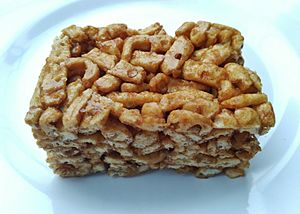Sachima facts for kids

Sachima
|
|
| Alternative names | Shāqímǎ |
|---|---|
| Type | Pastry |
| Place of origin | China |
| Created by | Manchu people |
| Main ingredients | Flour, butter, rock sugar |
| Variations | by region including raisins, sesame, coconut, etc |
| Similar dishes | Mayway mont |
| Sachima | |||||||||||||||||||||||||
|---|---|---|---|---|---|---|---|---|---|---|---|---|---|---|---|---|---|---|---|---|---|---|---|---|---|
| Chinese name | |||||||||||||||||||||||||
| Traditional Chinese | 沙琪瑪 | ||||||||||||||||||||||||
| Simplified Chinese | 沙琪玛 | ||||||||||||||||||||||||
| Hanyu Pinyin | shāqímǎ | ||||||||||||||||||||||||
| Cantonese Yale | sākèimáh | ||||||||||||||||||||||||
|
|||||||||||||||||||||||||
| Alternative Chinese name | |||||||||||||||||||||||||
| Traditional Chinese | 薩其馬 | ||||||||||||||||||||||||
| Simplified Chinese | 萨其马 | ||||||||||||||||||||||||
| Hanyu Pinyin | sàqímǎ | ||||||||||||||||||||||||
| Cantonese Yale | saatkèimáh | ||||||||||||||||||||||||
|
|||||||||||||||||||||||||
| Second alternative Chinese name | |||||||||||||||||||||||||
| Traditional Chinese | 馬仔 | ||||||||||||||||||||||||
| Simplified Chinese | 马仔 | ||||||||||||||||||||||||
| Hanyu Pinyin | mǎzǎi | ||||||||||||||||||||||||
| Cantonese Yale | máhjái | ||||||||||||||||||||||||
|
|||||||||||||||||||||||||
| Manchu name | |||||||||||||||||||||||||
| Manchu script | ᠰᠠᠴᡳᠮᠠ | ||||||||||||||||||||||||
| Abkai | saqima | ||||||||||||||||||||||||
| Möllendorff | sacima | ||||||||||||||||||||||||
Sachima is a yummy, sweet snack from China. It's made from soft, fried dough strands. These strands are held together with a sweet, sticky sugar syrup. It looks a bit like the Rice Krispies Treats you might know!
Sachima first came from a region called Manchuria. Today, it is a very popular treat all over China. Even though its look is mostly the same everywhere, its taste and decorations can be different depending on where you are in China.
Contents
What are the different kinds of Sachima?
Sachima changes a bit from one region to another. Let's explore some of these tasty variations!
Manchu Sachima: The Original Treat
The original sachima comes from Manchu cuisine. It is a sweet snack made mainly from flour, butter, and rock sugar. This classic version is loved by both kids and adults across mainland China.
Cantonese Sachima: Sweet and Topped
The sachima from Cantonese areas is usually a little sweet. It uses the same basic ingredients as other types. However, it often has fun toppings! You might find it sprinkled with sesame seeds, raisins, or dried coconut. Cantonese sachima can be chewy or crunchy. Many Chinese communities around the world, especially in Chinatowns, sell this style. It is very common in Hong Kong.
Fujian Sachima: A Simpler Taste
In the Fujian region, many companies make packaged sachima. This version often has sesame seeds. It is made with wheat flour, vegetable oil, egg, milk, regular sugar, and malt sugar. Its taste is usually plainer compared to the sweeter Cantonese version.
Mauritian Sachima: "Macaroni Cake"
In Mauritius, people call sachima "gâteau macaroni." This means "macaroni cake." It is a traditional Chinese cake. Sino-Mauritians often sell and enjoy this sweet treat.
Myanmar (Burma) Sachima: Mayway Mont
A similar snack in Myanmar (Burma) is called mayway mont (မရွေးမုန့်). This treat is made from puffed grains of sticky rice. These grains are held together with a sweet syrup called jaggery. It is a popular traditional Burmese snack or mont.
Vietnam Sachima: Bánh Bỏng Gạo
In Vietnam, there is a similar dish called bánh bỏng gạo or khẩu sli. It is made from puffed grains of sticky rice. These grains are mixed with sugar and ginger. Sometimes, peanuts are added too. This is a traditional dessert of the Tay people and Giay people. It is also popular in northern regions like Lai Chau, Cao Bang, and Bac Giang.
See also
 In Spanish: Sachima para niños
In Spanish: Sachima para niños

